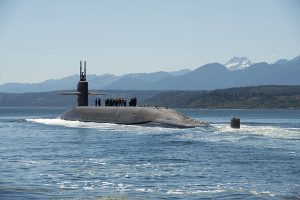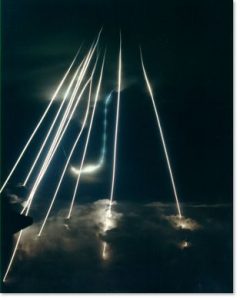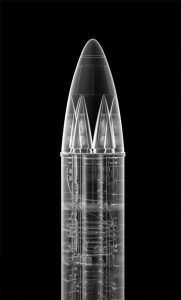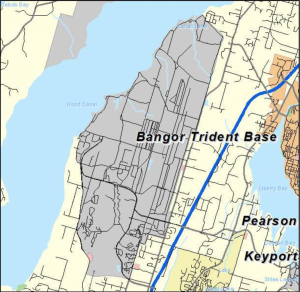
Henry Best
When examining why the military accumulates nuclear weapons, we must hope that these weapons will never be used. The military’s philosophy is that the intimidating factor of possessing the largest stockpile of Weapons of Mass Destruction can serve as a deterrent against enemy attack. By looking into technical capabilities of these weapons, as well as the social and environmental impacts that come along with the infrastructure necessary to harbor these weapons, we can gain a better understanding the effects of nuclear weaponization on the Kitsap Peninsula. As the most concentrated delivery system of nuclear weapons on Earth, Trident submarines at Bangor, part of Naval Base Kitsap, provide a useful case study.
Trident submarines, also known as Ohio-class SSBNs (Ships, Submersible, Ballistic, Nuclear) are the deadliest weapons systems in the world. They are undetectable due to acoustic quieting and can aim at targets 7,000 miles away. The USS Pennsylvania is the largest and most lethal weapon in the U.S. Navy. These submarines are capable of destroying entire countries with just one extremely accurate missile with multiple warheads attached. They use a unique missile system called “Multiple Independently targetable Reentry Vehicle” (MIRV), which is a single missile that contains multiple warheads with the ability to hit multiple targets. MIRV gives an Intercontinental Ballistic Missile (ICBM) with the strategic capability of carrying multiple thermonuclear warheads (Buchonnet 1976).

The Trident submarines designed to hold MIRV missiles can withstand extreme depths of over 250 meters and can stay underwater for 20 years without refueling. The passengers on these ships hold are able to breathe by the electrolysis mechanism of extracting oxygen from the surrounding seawater. The torpedos expelled by the submarines are so precise and flexible in their movement and direction that they can still be steered after they have been launched, using a trail of optic fibers to transmit and receive signals from the captain. The Tridents differ from those submarines used for scientific research. The deep sea diving submarines used for scientific purposes are made of syntactic foam, composed of microspheres, which then allow it to exceed depths greater than military submarines. Military-grade submarines contain their own nuclear power plant, allowing the vessel to stay under for as long as the food resources stay plentiful and the sanity of the crew is maintained (Discovery 2013).
Activism against Tridents
The Ground Zero Center for Nonviolent Action, an activist organization founded in 1977, was first successful in gaining public attention by gathering several thousand protesters to protest against the arrival of the first Trident submarines in Hood Canal in 1982. Ground Zero also brought to light the incoming transportation of nuclear warheads to Naval Base Kitsap by rail cars from the Pantex assembly plant in northern Texas. By focusing on the fact that nuclear warheads were moved by train across the country, the group was able to expand the anti-nuclear weapons campaign not just in Washington State but around the country. One of the main points of the Ground Zero activist organization is that the use of nuclear weapons would result in the end result of life as we know it (Ground Zero 2018).
Because of the protests to mobilize against the trains moving nuclear weapons across the country the U.S. Department of Energy was forced to stop shipping warheads by train and instead begin moving them by unmarked trailer trucks. The vast network of nuclear transportation allows for the United States military to create one of the largest repositories of nuclear weapons in the Western Hemisphere, located just 20 miles outside of Seattle on Bangor military base in Kitsap County, Washington.
Bangor is home to one-third of all nuclear weapons on Earth, stored either on the military base or located directly on Trident submarines, totaling 1,200 warheads. There are eight Trident submarines that hold 20 D5 missiles per sub. Each ballistic missile holds four to five nuclear warheads, accounting for 90 nuclear warheads per submarine. The warheads are W-76 100-kiloton or W-88 455- kiloton bombs. Of the eight submarines, five are usually out at sea when they are not receiving maintenance at Bangor submarine base. Three of the five submarines are consistently on “hard alert”- meaning that at any time they are ready and capable of deploying nuclear weapons (Glen Milner 2019)
Concentration of nuclear weapons
Bangor military base has the largest concentration of nuclear warheads on the Earth (Baskin 2016). In Kitsap County alone there are more nuclear warheads than Britain, China, France, India, Pakistan, Israel, and North Korea combined, making Kitsap County the third largest nuclear power on Earth, after the (rest of the) United States and Russia. This concentration feeds a concern among scientists and community members that the mishandling or improper maintenance of these weapons could lead to disastrous consequences.
Historically, the United States has a record of mishandling weapons capable of mass destruction. For example, on September 18, 1980, the entire state of Arkansas was nearly contaminated when a socket fell from a nuclear silo, puncturing a hole in a fuel tank and starting a fire. A nuclear weapons accident is referred to as a “broken arrow,” particularly when a nuclear weapon is cracked or jeopardized. The U.S. government acknowledges that there have been 32 mishaps involving malfunctions at U.S nuclear installations (Kenner 2017).
Another issue of concern is the hundreds of other declassified documents obtained by journalist Eric Schlosser, documenting everything from minor mishaps, all the way up to events considered more serious. “Accident 29” is described in a form classified document: “Warhead was damaged as a result of falling during handling operations. Extensive damage resulted in the automatic inflight insertion mechanism. MC-79 Electrical Connector Assembly, core charge and the high explosive sphere and case. No fire or detonation” (Schlosser 1996). The document does not specify where this incident occurred. The information obtained by Eric Schlosser includes hundreds of minor and not so minor incidents.
Trident D5 missiles
Each Trident D5 missile weighs 135,000 lbs. The rocket propellant is more volatile than TNT. A single Trident missile’s rocket propellant has the volatility of 155,000 pounds of TNT, and each Trident submarine has the capacity to hold 24 DII D5 ballistic missiles in its launch tubes. The Trident II D5 missile was built by Lockheed Martin for the Navy. The D5 missile carries multiple (MIRV) warheads allowing for each of them to hit a different target at a range in excess of 4,000 miles. The Navy is creating ways to modernize the warheads to extend their lives past 30 years (Glen Milner 2019 ).

The military test launches four D5s missiles every year without their warheads to verify missile reliability. This raises alarming concerns, considering the fact that if just one of these missiles was dropped around the ports where the submarines are docked, it would have the capability of destroying an entire submarine. Although this would not cause a nuclear explosion, it could create a large leak of plutonium that would contaminate the Puget Sound region. Depending on the hydrology of the location, the leak could spread to other regions of the state, because plutonium can stick to particles in soil, water, and sediment.
Naval Undersea Warfare Center, Keyport
The Naval Undersea Warfare Center is located near Bangor at Keyport, Kitsap County. Because of Keyport’s strategic location and proximity to Bangor submarine base, the port allows for easy access to the repair and maintenance depot for torpedoes and other undersea warfare systems. Like many other military installations, Keyport is considered to be a polluted area, designated as a Superfund site by the EPA. Environmental impacts on Keyport occur from contaminated soil, water or sediment.

Superfund sites are polluted areas considered to be “hazardous to communities health safety and quality-of-life” (EPA 2018). The EPA’s Superfund program is responsible for cleaning up some of the nation’s most contaminated land and responding to environmental emergencies, oil spills, and natural disasters. Map of Bangor Trident Base and Keyport (Credit: ESRI Street maps NA)
To protect public health and the environment, “the Superfund program focuses on making a visible and lasting difference in communities, ensuring that people can live and work in healthy, vibrant places” (CERCLA 1980). Military industrial activities have resulted in a wide range of environmental pollution including thousands of polluted Superfund sites. The concentration of contaminants varies from erroneously spilled highly toxic concentrations to nearly undetectable concentrations that may be detrimental to human health after prolonged exposure (Alexander 1999). The cost of cleaning up contaminated places is very high. In the United States alone, $60-80 billion per year is spent on restoration and worldwide costs range from $2.5 billion to $50 billion (Glass, 1999) ; (Tsao, 2003). Engineering methods for contaminated site repair include excavation, transportation, soil washing, extraction, pumping, and treatment of contaminated water, the addition of reactants such as hydrogen peroxide or potassium permanganate, and incineration (EPA 2018).
It is important not only to understand the environmental impacts of mishandling nuclear warheads, but also the current cost to the environment of manufacturing and storing Weapons of Mass Destruction even if no accident occurs.
Global opposition to Trident submarines
Public outrage against Trident nuclear weapons housed in Faslane naval base in Argyll, United Kingdom led to protests. On April 2013 a Day of Action resulted in a blockade of the Faslane Trident base. The blockade “was part of an action calling on the UK government to scrap plans for Trident renewal” (BBC 2013 ).
The protest was organized as part of 100 different protests in approximately 12 countries demonstrating the global opposition to military nuclearization and increased military spending. According to an article by The Economist, “Trident-armed submarines are expected to need replacing in the early 2020s; the system is due to be renewed, at a cost of £20 billion ($32 billion)” (The Economist 2010). In January 2016, the British House of Commons voted in a majority to continue the nuclear renewal plan Dreadnought-class submarine which would phase out the old system out by the year 2023 (BBC 2016).
Conclusion
Judging from the signs that the United States and much of the world powers show no real interest in denuclearization, it is up to the people to apply overwhelming pressure to their governments and institutions in order to call for the end of nuclear weapons. As the highest concentration of nuclear weapons on the planet, Kitsap County has become a place where weapons of Mass Destruction have been both normalized and vilified.
Sources
Annisimov, Michael. (2018, December 19). What are some different types of Submarines? Conjecture Corporation.
BBC. (2013, April 15). Protesters stage anti-Trident blockade at Faslane. BBC News Services.
Defense Atomic Support Agency. (1966, March 1). Accidents and Incidents Involving Nuclear Weapons. Defense Atomic Support Agency.
The Economist. (2010, September). Gunning for Trident. The Economist.
Ground Zero Center for Nonviolent Action (2018, February 12). GZCenter.org.
Gunter, Julie. (2013, April 24). Washington youth pair anti-nuclear action with Scottish protests. National Catholic Reporter.
Largest Dams. (2013, 28 September). The Largest Submarine in The U.S. Navy. YouTube.
National Security Archives. (1997, June). George Wahington University.
Mies, Richard W. (1999). The SSBN in National Security. Undersea Warfare magazine, 2 (1).
Mizokami, Kyle, (2018, April 11). Here are all the fighting Submarines of the U.S. Navy. Hearst Magazine Media, Inc.
Roblin, Sebastien (2017, January 21). Why Russia and China fear America’s Ohio-class Submarines. Center for the National Interest.
Sisk, Richard. (2019). Fate of Nuclear Sub Base in Scotland Unclear after Brexit. Military Advantage.
The Guardian. (2016, July 19). SNP push again for Scottish independence vote after Trident result. The Guardian.
United States Environmental Protection Agency.(2018, April). Superfund Sites in Reuse in Washington. EPA.gov.
United States Navy- Fact File. (2017, October 24). Fleet Ballistic Missile Submarines- SSBNs. United States Navy.
WGBH Educational Foundation. (2019). Broken Arrows: How Many Nuclear Accidents Have We Had? pbs.org.
